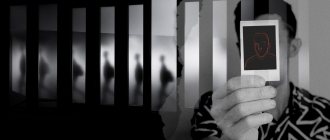Social perception concept
The emergence and successful development of interpersonal communication is possible only if there is mutual understanding between its participants. The extent to which people reflect the characteristics and feelings of another, perceive and understand others, and through them themselves, largely determines the process of communication, the relationships that develop between partners, and how they carry out joint activities. Thus, the process of perception and understanding of one person by another is an obligatory part of communication; it can be conditionally called the perceptual side of communication.
Social perception is one of the most complex and important concepts in social psychology. One could even argue that this is one of the most significant contributions of social psychology to modern and future human psychology.
Its closeness to the general psychological concept of perception stems from its name, its most general meaning in life, and also from the fact that both of them deal with the mechanisms and phenomena of human perception of various phenomena. This is where the similarities end. Perception is a theoretical concept that characterizes an artificially selected area of the holistic process of human perception and subjective comprehension of the world. Social perception is a complex, multi-component concept that attempts to explain the unique phenomenon of knowing and understanding each other.
Social perception concept
The concept of social perception was first introduced by J. Bruner in 1947, when he developed a new way of thinking about how people perceive each other.
Social perception is a process that occurs when people interact with each other and involves people's perception, learning, understanding and evaluation of social objects: other people, themselves, groups or social communities.
Social perception includes everything that in general psychology is designated by various terms and is studied separately in order to then create a complete picture of a person’s mental world:
- own process of perception of observed behavior;
- interpreting what is perceived in terms of causes of behavior and expected consequences;
- emotional assessment;
- building a strategy for your own behavior.
What is perception in psychology?
Perception in psychology is cognition. With the help of such perception, a person can mentally form a complete image of an object. In other words, such a reflection of reality is a unique sensory representation that is formed through:
The image depicts a scene in the Avenida on the 9th of July in Buenos Aires, where a large imaginary tear is created by an advertisement that tries to tell us ever so subtly that space in these apartments may be required. The beautiful model is literally built into an apartment building. This scene could very well be called sex and architecture.
At the same time, in Montreal, Canada, a young woman addressing the audience wears a bullet band around her waist as part of her aggressive outfit, with which she intends to draw our attention to the real specter of violence. As we see, this first example of the production of urban imaginaries, following our proposed model, is beyond the bounds of empirical evidence and comes to be perceived within an extreme social subjectivity that does not allow any evidence according to the traditional methods of the social sciences.
- motivation;
- installations;
- experience;
- personal characteristics of the perceiver;
- knowledge of the world through the prism of understanding one’s own “I”.
Process of perception
The process of social perception is a complex and branched system of forming images of social objects in the human mind as a result of such ways of people understanding each other as perception, cognition, understanding and learning. The term “perception” is not the most accurate for defining the formation of an observer’s perception of his interlocutor, since this is a more specific process. In social psychology, to more accurately characterize the process of a person’s perception of another person, an expression such as “perception of another” is sometimes used.
This process involves the relationship between the subject of perception and the object of perception.
The subject of perception is an individual or group that perceives and transforms reality. If the subject of perception is an individual, he can perceive and recognize his own group, an out-group, another individual who is a member of his own group or another group. If the subject of perception is a group, then the process of social perception becomes even more complex and complex, since the group can perceive both itself and its members, as well as evaluate members of another group and another group as a whole.
A feature of the perception of another person is that the subject and object of perception perceive not only the physical characteristics of the other, but also behavioral ones, and also in the process of interaction, judgments are formed about the intentions, abilities, feelings and thoughts of the interlocutor. In addition, an understanding of the relationships connecting the subject and object of perception arises. This gives even greater importance to a number of additional factors that do not play such a large role in the perception of physical objects. When the perceiver actively participates in communication, this means that the person has the intention to establish joint action with a partner, taking into account his intentions, desires, expectations and past experiences. Thus, social perception depends on emotions, intentions, opinions, attitudes, biases and prejudices.
Social perception is the perception of a person’s external characteristics, comparing them with his personal characteristics, interpreting and predicting his actions on this basis. Thus, social perception necessarily includes an assessment of another person and the development of a certain attitude in the emotional and behavioral aspect depending on this assessment and the impression made by the object. This process of getting to know another person, evaluating him and forming a certain attitude is an integral part of human communication and can conditionally be called the perceptual side of communication.
Perception in philosophy
Perception in philosophy is sensory understanding, the reflection of things in consciousness through the senses. This concept has several categories:
- Internal perception by which a person is aware of where his limbs are, whether he is sitting or standing, whether he is depressed, hungry or tired.
- External perception, which uses vision, hearing, touch, smell, taste.
- Mixed perceptions that manifest themselves through emotion or caprice.
Perceptual hook
At the moment of perception, the observed person appears before the observer as a certain set of socially significant attributes that are traditionally used to translate psychological traits and states in a particular culture. Attributes, or, as they are also called, “perceptual hooks,” which are the well-known social code of a particular person. The meaning of most of them was deciphered for him by his parents and other close people, some were deciphered by him, and some were assigned to him in the process of communicating with examples of his culture. These “hooks” are partly international: their interpretation is almost the same in different cultures and communities. At their core, they are attributes that decipher basic human emotions for us: Joy, fear, pain, etc. The rest, and they are the majority, are of “local significance”: born into a certain ethnic, social or even professional group. To interpret them correctly, it is important to know the culture of a particular group; it is better to be involved in it from birth.
A person's face is the main source of information about the perceived person. Of all the parameters, the most important for us are facial expression and eyes. Micro movements of the facial muscles can convey a wide range of feelings and experiences. The most important and “honest” information is provided by facial expressions about a person’s state: he is happy, sad, angry, worried. From the point of view of translating stable personality traits, its capabilities are very limited.
Enough has already been said about the eyes as the “mirror of the soul.” It should only be noted that the eyes themselves (from a materialistic point of view) are meaningless. They are created thanks to micro movements of the muscles around the eyes. But they do it masterfully, and our ability to perceive and interpret these movements is equally masterful. Here are just a few of the culturally embedded interpretations.
Direct look. Research shows that a person is not able to perceive the direct gaze of a communication partner for more than three seconds without feeling discomfort. The “right to a long, straight look” is correlated in culture with a person’s status and power: The greater they are, the longer a person can look “straight”.
Direct gaze is perceived subjectively:
- Like a challenge;
- As a proposal to reduce personal distance in communication.
Refusal of eye contact. Subjectively perceived by the observer as punishment or a means of manipulation.
"Eyes that do not see." Subjectively perceived as an indicator of aggressive intentions, threat or defensive (usually also aggressive) reaction.
Methodology for the development of perceptual perception
According to the famous psychologist Dale Carnegie, a simple smile is enough to evoke sympathy from others. That is why, if you want to build a strong communication connection with others, you should learn how to smile correctly. Today, there are many psychological techniques for developing facial gestures that help enhance the transmission of experienced emotions. Managing your own facial expressions allows you not only to improve the quality of social perception, but also to gain the opportunity to better understand others.
One of the most effective methods for developing social perception skills is the Ekman practice. The basis of this method is to focus on three zones of the human face. These areas include the forehead, chin and nose. It is these zones that best reflect emotional states such as feelings of anger, fear, disgust or sadness.
The ability to analyze facial gestures allows you to decipher the feelings that the interlocutor experiences. This practice has become widespread in the field of psychology, thanks to which a specialist has the opportunity to build a communicative relationship with persons with mental disorders.
Perception is a complex mechanism of human mental perception. The quality of operation of this system depends on many different external and internal factors. Such factors include age, experience and individual personality traits.
Human gestures and postures
In the post-war years, a fairly popular area of research in social psychology was the compilation of catalogs of culturally typical gestures and postures.
Here are some examples of expressive gestures that have universal meaning in European culture:
- Clasped fingers - shame, humility, humility;
- One finger clamped in the palm of the other hand - self-confidence;
- Various “scratching” of the head - indecisiveness, unpreparedness.
In recent years, much has been written about poses as a means of self-expression. Let us only emphasize that the best studied set of behavioral reactions (postures, gestures) expressing the attitude towards a partner according to the following parameters: avoidance - approach, openness - closedness, dominance - submission. For example, spatial communication distance indicates the closeness or formality of contacts. American anthropologist and psychologist E.
Hall developed for his culture some norms of physical distance that correspond to different types of relationships:
- Intimate distance - 0 - 30 cm;
- Personal distance - 30 - 120 cm;
- Social distance - from 120 to 360 cm;
- Public distance is 360 cm or more.
Human voice and speech
On the one hand, each person has a unique, inimitable set of characteristics of voice and speech: Intonation associated with the volume and length of sentences, characteristic pauses and interjections in speech…. On the other hand, many voice parameters carry socially significant information that helps to “decode” their owner in communication situations.
The volume of the voice reflects the degree of dominance of a person in the communication space. A subjectively loud voice is associated with personal characteristics such as self-confidence, social courage and competence.
Pauses are another indicator of confidence. The absence of pauses is often interpreted as anxiety, uncertainty in one’s words. A pause is a well-known means of controlling a conversation and manipulating a person’s state.
The pace of speech is associated with temperament (which is quite fair); less often, a sensitive observer uses it to diagnose a person’s physical condition. An important aspect of communication is matching the rate of speech of the interlocutors. By slowing down or speeding up the pace of your own speech, you can actively influence both the course of the conversation and the state of your interlocutor.
Functions of social perception
There are basic functions of social perception, namely: recognizing oneself, recognizing a communication partner, organizing joint activities based on mutual understanding and establishing certain emotional relationships. Mutual understanding is a social and mental phenomenon at the center of which is empathy.
Empathy is the ability to empathize, the desire to empathize with another person and accurately determine his emotional state based on actions, facial reactions, and gestures.
Empathy is based on the ability to correctly imagine what is going on in another person's head, what he/she is experiencing, how he/she evaluates the world around him. It is known that the better a person can imagine how the same event is perceived by different people, and the extent to which he recognizes the right to the existence of these opinions, the higher his empathy. Personal experience of various psychological experiences is also of great importance, since it is difficult to imagine that you can experience the emotions of another person if you have never experienced them yourself. Thus, in a sense, empathy is the ability to reason by analogy, although such a definition does not provide an exhaustive answer to the question of the nature of this phenomenon.
Types and examples of perception
Each sense organ has its own type of perception. Obviously, their information content is very different. At the same time, in people deprived of sight or hearing, other senses are heightened and allow them to receive information more effectively. For example, Braille allows blind people to read at a fairly high speed.
Let's look at each type of perception with examples:
- Visual. Vision is our main way of perceiving the outside world. It has the greatest information content, because no other sense organ can perceive information in such quantities and at such speed. In addition, it is the most versatile. With its help, we can see different images, obtain information by reading text, studying graphs or diagrams.
- Auditory. Hearing is the second most informative sense after vision. It gives us a large amount of valuable information about the world around us, helps us navigate in space and determine the location of the source of noise. In addition, speech and hearing make verbal communication possible.
- Tactile. Our skin contains a large number of receptors that respond to touch and temperature. Most of these receptors are located on the fingertips. Thanks to this, we can learn a lot about objects simply by touching them. And for people who are blind, tactile perception allows them to read texts written in Braille.
- Tasty. From nature's point of view, we need taste to determine which foods are healthy and nutritious and which may be harmful to health. Although today we use it mainly to enjoy delicious food.
- Olfactory. The sense of smell plays a vital role for animals - with its help they find prey and learn about danger in time. For a person, this feeling is less significant. And yet it allows, for example, to determine the quality and freshness of products by smell, which is also important.
- Vestibular. The sense of balance allows us to determine our position in space, as well as to sense movement and acceleration.
The listed types of perception are associated with specific sense organs. Psychologists distinguish two more types of perception, based not on sensations, but on understanding:
- Spatial. This form of perception helps us to be aware of the positions of objects in space, their sizes and the distances between them. Thanks to it, we can take something from the table with our eyes closed, and drivers “feel” the dimensions of the car when driving into the garage.
- Temporary. We are able to sense the passage of time. If we are talking about long periods, the error can be quite large. But in the case of a rhythmic process, the accuracy can be simply amazing. For example, if music is playing and some measure is longer, even a person who does not have an ear for music will notice this.
Psychology also considers such concepts as interpersonal and social perception - we will talk about them in more detail.
Mechanisms of social cognition
Social reflection
Social reflection is the internal representation of the Other in the inner world of a person. Here is what E. Melibruda writes: “The person who is the object of my perception is not just a source of signals that I receive and process. I perceive him as a subject who perceives me, who thinks about me, who evaluates me, who understands me..... I not only introduce him into my inner world..., but I also make sure that this person is present in me, like that , who in turn introduces me to his inner world. Imagining what others think of me is an important aspect of social cognition. This is both knowing another through what he thinks (as I think) about me, and knowing myself through the hypothetical eyes of another.
Attraction
In this context, this term refers to a mechanism for understanding a communication partner based on deep feelings for him or her. And it doesn’t matter what sign this feeling has: It is easier to understand a friend and an enemy than a stranger and a stranger who is unfamiliar to you. Attraction does not guarantee the formation of an “objective” image of a person; it gives an understanding of his feelings, states, and ideas about life. Although, from the point of view of A. Maslow, attraction is the path to objectivity: “...the perception of a loving person..... allows a lover to feel the object of his love so subtly, to know him so fully, as someone who does not love can never. A. Maslow sees the source of such rich cognitive capabilities of attraction in the fact that a loving person is less inclined to control, manipulate, and “improve” the object of love. If you accept a person for who he is, says the outstanding humanistic psychologist, then you are objective in your assessments.
Illusory correlations
Unfortunately, people tend to attach decisive importance to some factors and completely ignore others that are no less important. “...Existence will be for them what they think it is” (Anaxagoras). Illusory contexts arise in a person due to past experience, family scenarios, professional or other stereotypes, age, gender. There are many reasons, but the result is the same: a distorted perception of the social situation and the people acting in it.
False Approval Error
The principle is simple: if another person acts as I did in this situation, his behavior is normal, if the opposite reactions are something wrong with himself, it seems, some kind of personal qualities. The error of false consent also occurs in cases where one’s own meanings are invested in the actions of another person: if I did this, it would only be for some reason.
Technology of perception development
Perception creates a picture of reality based on the activity of an entire system of brain analyzers. The process of perception is physiological. Soviet psychologists L. Vygotsky and A. Zaporozhets talk about motor skills and vision as important factors in the development of perception. Eye movement plays an important role in the development of visual perception.
A fixed eye cannot perceive objects as a whole. With kinesthetic perception, connections arise, including space and time. With this type of perception, the reverse process occurs, providing control over the hands, which perform a variety of actions: from micro-movements to modeling.
For a person, the first significant changes in the perception of the world and perceptual actions occur in the first years of life. One of the decisive roles is played by sensory perception; from childhood, the accumulation of ideas about the color palette, shape, properties and size of surrounding objects begins.
Development technologies can be very diverse. Educational games that bring actions to automaticity, for example, comparing quantities through game manipulations, in which new information is learned. Gradually, the comparison of figures turns into visual perception, and the movements of the hands become more complex, and the sense of touch is involved.
Active search actions and the formation of connections between vision, hearing and touch make it possible to perceive complex signals, distinguish them, build connections, recognize and interpret.
Thus, not only is perceptual development important in its own right, but it is also an example of behavioral and neural plasticity—powerful mechanisms that can support developmental changes in many areas, beginning in early life.
Stereotyping
A stereotype is a stable image or idea of any phenomena, persons, or events, characteristic of representatives of a certain social group. Stereotyping is the process of forming an impression of a perceived person based on stereotypes developed by a group.
Various social groups, real (nation) or ideal (professional group), develop stereotypes, stable explanations of certain facts, habitual interpretations of things. This is quite logical, because stereotypes are a necessary and useful tool for social perception of the world. This allows you to quickly and reliably classify and simplify the social environment at a certain level. To make it understandable and therefore predictable.
The emergence of social stereotypes is associated with certain social situations. In any specific situation, this or that image performed the listed functions well, and therefore became entrenched in the form of a stereotype. But the social position of the group and its members changes much faster than the stereotypes they create. Thus, the stereotype takes on a life of its own and influences the development of the group's relationships with other people and between a particular person and other people.
Group stereotypes in their formation often go through a stage associated with the formation model of “social pronouns”: “they - we - I”. More precisely, first the other group (the one in relation to which the stereotype is formed) has a qualitative definition. One's own group is literally defined as “that which is not...”, that is, through negation. Only later do their own qualities appear, which are not necessarily based on the “vice versa” principle.
Audience effect
A person does the same things differently when alone and in the presence of other people. Moreover, observers can influence both positively and negatively. For example, a person will perform better at work that is familiar to him and perform worse at new assignments when someone else is near him.
Psychologist Robert Zajonc believed that observers cause arousal because their reaction to a person’s actions is unpredictable. When a person does what he knows and knows, it is easier for him to cope with psychological stress and fear of evaluation than if he takes on a completely new unfamiliar task.




